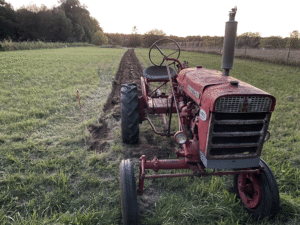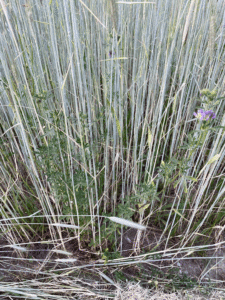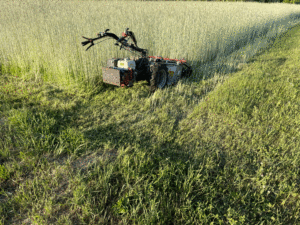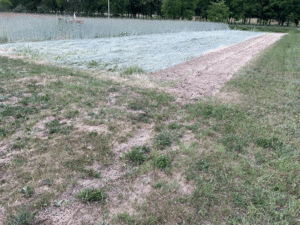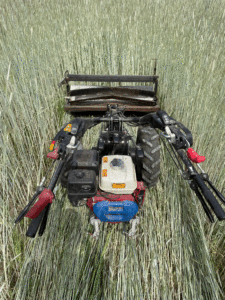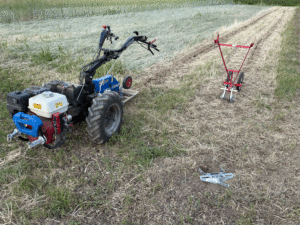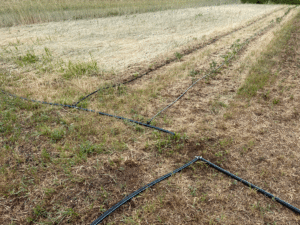Final report for FNC23-1397
Project Information
Phillip Swartz - Farmer, Rancher, and Fabricator
I'm a sixth generation farmer raised on a Midwest corn and soy farm by my welder/fabricator father. I studied engineering at the University of Illinois and graduated with a Bachelor of Science in Geology. Currently I work for a custom metal fabrication shop in Kalamazoo, MI.
My farming operation, Fresh Coast Farms, consists of rotationally grazing goats and chickens on 20 acres of diverse pasture. My wife, Chanterelle, and her sister, Sureau, began requesting my assistance with fabricating implements and tools that address specific issues they are experiencing while trying to improve efficiency and sustainable farming practices within their vegetable growing operation. My other farming enterprise, beyondsustainable.farm, is dedicated to the development and advancement of innovative and appropriate technology solutions for regenerative agriculture. I have already designed and fabricated a roller-crimper for the BCS two wheeled tractor.
Chanterelle Vogtmann-Owner, Founder and Head Grower at Silverbeet Farm LLC.
I have been working in agriculture for over 15 years. Learning primarily through hands-on experience, collaborating with mentors and fellow farmers and attending agricultural conferences and field days. I have knowledge and experience in a wide range of agricultural specialties including working in the commercial bedding plant industry, co-founding and operating a 20 acre certified organic orchard, cider mill and vegetable CSA, and founding and running Silverbeet Farm.
Silverbeet Farm is a 6 acre diversified vegetable and flower farm and family homestead established in 2016. We grow high-quality produce and plants for our local farmers market, CSA program, wedding florals and restaurant sales. Crops include but are not limited to heirloom tomatoes, winter squash, specialty lettuces and baby greens, culinary mushrooms, root crops and alliums and transplants. Our focus is on sustainable, holistic practices and soil health.
Sureau Vogtmann- Farm Manager at Silverbeet Farm LLC.
I have a bachelor's degree in Sport and Recreation Management with a focus on Outdoor Leadership and Education. I began working at Silverbeet in 2016 as a field hand and to help with farmer’s market sales and have been the farm manager since 2019. Some of the many farm responsibilities I am involved with include operating the BCS two-wheeled tractor, and collaborating on all aspects of crop planning, seed starting, planting, harvest, post-harvest and sales/distribution.
Currently, there isn't a viable solution or commercially available tool for small-scale vegetable farms to efficiently implement no-till planting into a roller crimped cover crop. No-till practices can be implemented at garden scale with hand tools and time-consuming physical labor or on large-scale farms using big tractors and technologically advanced implements.
Specifically, there does not exist an affordable or readily available no-till planting implement for two wheeled tractors such as the BCS. Some innovators, including ourselves, have developed roller crimpers for the two-wheeled tractor that will successfully terminate cover crops like cereal rye, however, we then face the challenge of planting tomato and winter squash seedlings by hand into a relatively hard seedbed. The potential labor saving benefits of using a roller crimped cover crop as mulch for these crops may be negated by the increased labor and time needed for hand transplanting into the hard seedbed
We believe that if a roller crimper and no-till planting system for the BCS two wheeled tractor was readily available to small scale vegetable growers, they would utilize those tools and there would be an in increase in adoption of cover cropping and no-till practices on vegetable farms.
Solution
We intend to solve this problem by designing a no-till planting implement that fits two-wheeled tractors such as the BCS which are affordable and widely used on small farms. We will build upon the extensive research on roller crimping and no-till systems from organizations like the Rodale Institute. We also plan to demonstrate the benefits by measuring soil health, recording labor inputs, and impact on quality of life. In order to do this we will establish two test plots for each year of the project. Plots will consist of two rows of heirloom tomatoes and two rows of winter squash, each row is 4’ x 300’.
2023: 1st year tomato test plot will be prepared using the BCS and rotary harrow, tomatoes will be hand planted and mulched using organic hay or straw mulch. Winter squash plot will prepared using the BCS and rotary harrow, squash will be hand planted and then hand cultivated to control weeds using a Terrateck wheel hoe throughout the summer of 2023. We will take soil samples from each plot to be tested spring and fall of 2023.
2024 plots will be adjacent to the 2023 plots, one for tomatoes, one for squash. These plots will be planted with cereal rye and vetch mix in fall of 2023 to overwinter for spring of 2024. Spring of 2024 we commence roller crimping of the rye/vetch, and plant tomatoes and winter squash directly into the roller crimped cover crop utilizing the no-till planter we plan to develop. Soil samples will taken from these test plots evaluated in spring and fall of 2024.
We chose heirloom tomatoes because they are an important crop for our farm. We think that they have the potential to thrive in a no-till cover cropped system and that this has the potential to save on inputs in terms of the cost of organic mulch/labor hours spent applying mulch and hand planting while maintaining the benefits of weed suppression, water retention, disease reduction and increased soil health.
We chose winter squash because research shows that it does well in organic no-till systems and we believe that having beds in our test plot that are manually/mechanically cultivated will be valuable in terms of comparing soil test results and manual labor inputs.
Due to the constraints of the two-wheeled tractor in terms of weight, horsepower, and traction we would like to design two different implements for no-till planting. The first will be adapted from ground driven no-till components such as row cleaners, wavy coulter, subsoiler, and rolling basket to create a small tilled furrow for planting. The second unit will incorporate a modified PTO mini-trencher that substitutes engine power for traction power possibly creating a more user-friendly experience.
Objective
- Design, fabricate, test, and improve a single row no-till planting unit to be used with the BCS two-wheeled tractor.
- Continue testing and improving our roller crimper implement.
- Trial the implements with cereal rye and hairy vetch mix cover crop + cash crop systems and evaluate how these fit into the vegetable crop rotation and the impact they have on labor input, soil health factors, and quality of life.
- Share our findings with the community and other farmers through an on-farm educational demonstration day, social media outreach, photos, and videos of the research.
- Publish detailed and easy to follow plans for farmers to fabricate their own roller crimper and no-till planting implement for a two-wheeled tractor.
- Continue discussions with Earth tools Inc. When consulted they indicated that there is considerable interest from small scale farmers in a no-till planting solution for two-wheeled tractors.
Cooperators
- - Producer
- - Producer
Research
The project began on this field in Fall of 2022 when we plowed approximately .25 acres of old hay field followed by the application and disc incorporation of the following materials:
- 50# potassium magnesium sulfate
- 50# pelletized gypsum
- 70# rock phospate
- 50# microhume
- 50# kelp
- 400# pelletized chicken litter from Herbrucks poultry ranch
- ~32 yards of composted and forest inoculated wood chips
This area was then seeded with 100# cereal rye, 10# Austrian winter peas, 5# red clover, and a mystery legume (most likely old alfalfa seed) which was lightly disced for incorporation. We chose this mix because we needed the cereal rye for the crimped down mulch in Spring 2023 season and the legumes were added because we had that seed on hand and wanted to get some nitrogen fixation if possible. Also, it has been well documented that multi-species cover crops perform better than a single species. This cover crop germinated and grew several inches of top growth before going dormant during the Winter of 2022-2023. In Spring of 2023 the cover crop was allowed to grow. There was an extremely dry stretch of weather from early May to Mid June and the cover crop did not produce as much biomass as expected.
On May 8, 2023 Phillip drove to Fennig Equipment in Coldwater, OH to pick up no-till components to be used in the project.
On June 4, 2023 we commenced termination of the cereal rye. In the half of the field where we are conducting this grant project we used the BCS to flail mow two beds. These beds were power harrowed with the BCS on June 9.
On June 10, 2023 the remainder of this half of the field was roller crimped with our BCS two wheeled tractor because we wanted to see how effective the roller crimping would be at this time.
On June 16 we used the trenching implement for the BCS to make a planting trench in the mowed/tilled cereal rye beds. This was to help us learn how to use the implement and gain insight into how it might be used as part of a no-till planting system. We also did some weeding with the Terratek wheel hoe. We applied ~20# pelletized chicken manure and pound of kelp per bed. We planted winter squash seedlings in one bed and tomato seedlings in the other bed.
We followed this by mulching a bed of tomatoes and cultivating a bed of squash to record our time for these tasks.
We took soil samples on July 11 from the areas that were not amended this season. Soil conditions at this time were still severely compacted from the lack of rain.
On October 11 we took another soil sample from the non amended parts of the field after adequate moisture had replenished the soil.
From October 11-13 we brought our herd of goats into the field to graze the cover crops: on one half of the field we had a very nice stand of medium red clover that had come through the roller crimped rye mulch and on the other half of the field we had planted a summer cover crop blend by discing it into the standing cereal rye.
On October 25 we disced the .25 acre field and seeded it with one bushel of cereal rye and 6 pounds of hairy vetch seed. We used the cereal rye to provide the biomass for the roller crimped rye and the hairy vetch was used to provide nitrogen fixation.
The cover crop put on several inches of top growth before going dormant in the winter of 2024.
2024:
Spring 2025 was unseasonably warm and early in Kalamazoo, Michigan. We estimated that the vegetation was 2-3 weeks ahead of normal based on when specific plants were flowering. The climate data for Kalamazoo, Michigan shows that the accumulated Growing Degree Days were 261 higher than normal.
The three main cover crops present in this field were cereal rye, medium red clover, and hairy vetch. These plants grew very well in these warm and wet spring conditions.
May 14,2024 - One bed (4' x 150') was mowed with the flail mower attachment on the BCS tractor.
Flail mowing is one method of terminating the cereal rye cover crop. The results are a short stubble of rye and finely chopped rye plant residue that covers the bed more or less evenly. This method will stop the growth and maturation of the rye plant if it also done during flowering of the seed heads. The mowed rye continues to provide some suppression of the annual spring weeds probably mostly through the alleleopathic effect and some mulching from the mowed residue. The undersown cover crops of vetch and clover will continue to grow after being mowed.
Earth Tools Co. has developed a "strip till kit" for the Caravaggi mini trencher which consists of a block off plate for the side discharge and rear discharge extension with flap. This creates a mini-tiller for the BCS tractor which actually works great in the mowed cover crop.
05/16/2024 - Phillip used this mini-tiller to create a narrow strip of tilled soil in the flail mowed cereal rye.
The cereal rye, clover, and vetch in the test plot grew very well and rapidly. Had we been tending this plot solely for market garden usage we would have roller crimped the rye sometime in mid May when the rye had reached antithesis and the flowers were clearly visible.
However, we had scheduled our Field Day for June 9, 2024 and reserved a majority of the rye to be crimped at the field day as a demonstration.
Under these circumstances the cereal rye was extremely mature at the time of roller crimping and this affected our project research in several ways:
- The plants were most definitely setting seed which will cause the field to be reseeded by volunteer rye plants (ie. plants that we did not intentionally sow)
- The rye had begun to lodge because it was mature by late May and then our farm received two very intense rain events with wind on June 1 and June 8. Lodging of the rye causes the stems to fall in a way that makes the roller crimping more difficult and the results of the roller crimping under these conditions make the no-till unit work more difficult and results inconsistent.
- Mature cereal rye that is actively setting seeds will be pulling more nutrients from the soil potentially creating nutrient deficiencies in the cash crop. This can be accounted for with additional in furrow fertilizer
- Mature cereal rye has a significantly higher Carbon to Nitrogen ratio (C:N) which in our experience (during the 2024 season) results in a stem that is more resistant to the roller crimping than in previous years.
05/16/24 Chanterelle took pictures of cereal rye in flower and standing tall, hairy vetch not quite flowering yet
05/31/24 Chanterelle took pictures of cereal rye starting to lodge and vetch in flower
06/01/24 Phillip roller crimped approximately half of the field of cereal rye/vetch/clover
06/09/24 Field Day where we demonstrated the following aspects of our no-till system to 19 attendees (farmers, gardeners, ag professionals, general public members):
- roller crimping some of the remaining beds of cereal rye/vetch/clover
- running the no-till furrow maker through the roller crimped beds
- follow up tillage pass with the single shank sub-soiler or 'ripper'
- discussed how and when to use the mini-trencher
We also took this time to show the Field Day attendees the additional no-till components and BCS implements.
This on-farm demonstration led to in the field brainstorming and collaboration. The benefits and challenges of this planting system were discussed. Additional innovations to the implements were discussed.
Over the next week after the field day the test plot rows were planted and the progress of the squash and tomato crops were documented by team members.
Jan 2025 note: Because of significant ongoing farmer input about the design, the how-to guide for building the roller crimper is not included at this time. However, if a farmer is ready to start experimenting on their own now, this narrative provides detailed descriptions about the equipment developed and how to use it in a vegetable operation. The grantees plan to add the how-guide to this report once the roller crimper designs are more refined and ready for widespread usage by other farmers.
On our farm we found that the tomatoes plants performed better and yielded better in the traditional tilled and mulched beds. The roller crimping and no-till furrow making is much faster and uniform than traditional mulching after planting. In the cereal rye mulched beds the tomatoes are planted into a mulch which can potentially protect the seedlings from soil splashing. This can be a concern because often we are planting right ahead of a rain with little time to mulch after a hard day of planting. The difference in yield may be overcome simply by planting slightly more area. Tomatoes planted into the roller crimped rye beds will generally be planted slightly later than into a traditional system because you are waiting on the cereal rye to mature enough before roller crimping.
The squash plants performed better in the roller crimped rye plot because the cereal rye mulch is really great at providing long term weed suppression while protecting the fruits from blemishes and dirt which can cause rotting of fruits. The clover crop may have helped improve pollination of cucurbit plants. In our conventional test plot of squash we were not able to mechanically cultivate as often as we would have like due to weather conditions - this allowed the proliferation of weeds.
We found that the BCS two-wheeled tractor is indeed capable of operating implements such as our roller crimper and no-till implement.
Based on input from farmers we modified our roller crimper mode of operation to be trailing instead of pushed by the BCS. Both methods have pros and cons. The beauty of the BCS tractor platform is that the direction of operation can be easily changed depending upon the preference of the operator for the task at hand. We also modified our roller crimper with strategically placed shields to help lay the cereal rye into a pattern that would help facilitate better functionality of the no-till implement. We want the rye stems to 'part' down the middle of the bed such that there is much less material right in the middle of the bed where the no-till implement will be working.
The no-till implement we designed really achieves a very discreet and simple goal of slicing through the thick mat of roller crimped cereal rye mulch and creating a slit that can then be planted into or further worked by other implements for the two-wheeled tractor. This action is quite appropriate for the scale at which these tractors are used and it is unrealistic to expect such a small platform to perform much more than this in one pass. What we are proving is that there can be a system for using cereal rye cover crop in an organic no-till market garden system where two wheeled tractors are commonplace power units.
The no-till implement and single shank subsoiler require quite a lot of traction to work successfully. We recommend using steel wheels and at least 90 pounds of additional weight per axle. Additional weights can be attached to the BCS transmission and these may be necessary in some soil conditions for best performance.
Spring time order of operations would be to use the roller crimper to terminate the cereal rye cover crop at the appropriate timing. Follow the roller crimping with the no-till implement. Then follow up with the single shank subsoiler and you will have a very nice strip through the rye for transplants or seeds. Alternatively, the rye can be mowed with a flail mower and then a strip tilled with the mini-tiller. This could also be followed with the single shank subsoiler if your soil conditions require more deep tillage to break up compaction.
The soil test results can be somewhat difficult to interpret as they are only a snapshot in time of what is going on in this plot. During the course of this project we were also fertilizing the test plots and grazing the cover crop with goats. All of these management practices can affect the nutrient availability at various times. To us the most dramatic change in the soil test is how the Soil Organic Matter went from 2.3% at the beginning of 2023 before the project officially started to 3.2% by the projects last soil sampling event in late summer 2024. We have also observed qualitative changes in the tilth of our soil in this plot. We feel very strongly that this type of cover crop and no-till planting system can help build healthy and resilient soils for small-scale market gardeners.
Educational & Outreach Activities
Participation summary:
February 2024 we have been continuing to document the project progress via photos and videos to be used for production of the field day brochure, social media posts, and final educational material. This spring and summer we will begin and complete the following list of education and outreach objectives.
April 2024: Advertise the farm field day through digital and physical publications using the variety of media collected to date.
May-November 2024: Documenting the project's second season.
June 2024: Conduct field day with on-farm demonstration of the roller crimping of overwintered cereal rye and hairy vetch. Demonstration of no-till planting system using our implement. Share and discuss project findings thus far. Provide field day participants with a brochure and request a brief survey be completed regarding the project's potential impact on quality of life.
November 2024-January 2025: Complete and publish the how-to guide for fabricating the no-till planting unit with necessary information about parts and design considerations.
January 2025: Complete and Submit final SARE report and share any final or updated findings on social media and with local conservation district and extension offices.
01/2025 Updates:
May 2024:
- Farm Tour given to three NRCS Kalamazoo staff
May/June 2024:
- Advertise on-farm field day through SARE press release.
- Distributed to local NRCS offices in Kalamazoo and Paw Paw, Michigan.
- Shared with our local partner (501(c3) charity that specializes in education and outreach regarding traditional farming skills) located in Scotts, Michigan
- Posted to Facebook, Instagram, and LinkedIn pages.
June 9, 2024:
- On-farm Field Day held at Silverbeet Farm in Kalamazoo, MI
- Attended by ~19 interested parties - local small scale farmers, livestock producer, compost and fertility consultant
- multiple demonstrations
- troubleshooting of implement and design considerations offered by fellow farmers including local fruit, vegetable and flower growers.
July 9, 2024
- Farm tour and demonstration given to the NCR-SARE executive committee and state level representatives
At various dates we have shared our progress through several different social media channels
January 2025
- consultation with members of a livestock operation in south Georgia that also has a good sized fresh vegetable garden and use cover cropping.
February 2025
- We will be attending the Marbleseed Organic Farming conference as exhibitors. Our display booth will be used for education and outreach to conference participants regarding
May/June 2025 we are planning on hosting an on-farm Field Day to demonstrate our continued progress
Summer 2025 we are planning to release, in conjunction with NCR-SARE, a multimedia virtual Field Day experience documenting our research and findings.
Learning Outcomes
We accomplished our main goal for the project - Design, fabricate, test, and improve a single row no-till planting unit to be used with the BCS two-wheeled tractor. We successfully roller crimped the cereal rye and then used our no-till implement to cut through the thick mat of rye mulch leaving a furrow that could be planted into directly or improved with further passes of other two-wheeled tractor implements like the mini-tiller and single shank subsoiler. We will continue to refine these implements and our no-till planting system with each season.
We have learned many valuable lessons from this project:
A benefit of the roller crimped beds is that the cereal rye mulch can provide extensive weed suppression during a variety of growing conditions like wet periods where mechanical cultivation does not work well or hot dry conditions where mechanical cultivation can be detrimental to soil biology and health. The roller crimped mulch helps keep the soil relatively cooler and hopefully more healthy.
On our farm we found that the tomatoes plants performed better and yielded better in the traditional tilled and mulched beds. The roller crimping and no-till furrow making is much faster and uniform than traditional mulching after planting. In the cereal rye mulched beds the tomatoes are planted into a mulch which can potentially protect the seedlings from soil splashing. This can be a concern because often we are planting right ahead of a rain with little time to mulch after a hard day of planting. The difference in yield may be overcome simply by planting slightly more area. Tomatoes planted into the roller crimped rye beds will generally be planted slightly later than into a traditional system because you are waiting on the cereal rye to mature enough before roller crimping.
The squash plants performed better in the roller crimped rye plot because the cereal rye mulch is really great at providing long term weed suppression while protecting the fruits from blemishes and dirt which can cause rotting of fruits. The clover crop may have helped improve pollination of cucurbit plants. In our conventional test plot of squash we were not able to mechanically cultivate as often as we would have like due to weather conditions - this allowed the proliferation of weeds.
In our climate this method of sowing cereal rye and medium red clover in the fall followed by roller crimping of the rye in the spring is maybe one of the best ways to establish a field of medium red clover. The clover germinates in the cool temperatures of fall and spring while being sheltered by the quick growing rye. After roller crimping of the rye the clover continues to grow through the mulch of cereal rye. Therefore the clover experiences very little competition from weeds and a relatively cool and moist soil in which to continue growing. The clover comes up through the cereal rye mulch and puts on a lot of growth. This combination of cereal rye mulch and medium red clover growth is really great for building soil while also providing nectar sources for bees, pollinators, and various beneficial insects. Clover growth can be controlled with a weed whip for a 'chop and drop' type mulch as to not compete with cash crops.
Flail mowing the cereal rye crop followed by strip tilling with the mini-tiller can be an effective way to utilize cover crops and no-till principles in the market garden setting. This method provides some initial weed suppression, however the effect is not as good or long lasting as the cereal rye mulch. The finely chopped rye residue from flail mowing can be easier to deal with at the end of the growing season. This method can work for a variety of crops and opens up a slightly earlier planting timeline than waiting for the rye to me mature enough for roller crimping.
In this system of roller crimping a cereal rye cover crop there are a lot of variables and factors which can affect the outcome. Plant population of the cereal rye is very important in producing enough biomass for the roller crimped mulch to successfully suppress weeds all season long.
Roller Crimping of buckwheat cover crop may provide an additional opportunity for using no-till principles in the organic market garden. Buckwheat grows quickly, provides resources for beneficial insects, and is very good for improving soil tilth. Buckwheat growth can be effectively terminated by the roller crimper and often the soil is then light enough for hand or trowel planting without further equipment passes. This method can be used for summer or fall cash crops. Buckwheat is a great cover crop for holding beds and protecting the soil biome during hot, dry conditions.
Oats make a great cover crop, however, the oat growth was not effectively terminated by roller crimping therefore this cover crop may not lend itself to working well in this type of no-till system.
Project Outcomes
We have had a variety of successful interactions with a wide range of farmers, ranchers, and agricultural professionals. Many different people with different perspectives have appreciated the work that we are doing to develop these implements and the type of land management system that is appropriate for their scale. Some express how these tools and systems can be very effective and useful for soil building methods.
One of our primary collaborators is a charitable organization in southwest Michigan that specializes in the education and outreach regarding traditional farming methods especially animal powered implements. Members of this organization have expressed an interest in working with us to develop these type of implements for their educational facility and potential export to Africa where they work on rural development initiatives.
We are continuing to use our experience with this project as part of our application for additional grants and funding opportunities.
We would like to continue our work to develop tools and methods for small scale farmers using these two-wheeled tractors. The implements and methods described in this report will continue to be refined and improved with each season. These practices can help increase the usage of cover crops while reducing the usage of plastic mulch.
Based on our findings we think there is a great opportunity to explore the feasibility of using this system to plant perennial crops like asparagus, fruit trees, berry plants/bushes, etc. For example, a small scale farmer could sow a cereal rye cover crop with medium red clover in the fall. The following spring the cereal rye could be roller crimped and then a furrow could be created using the no-till implement and subsoiler. Perennial crops could be planted into this furrow. The cereal rye would provide weed suppression while the medium red clover continues to grow during establishment of the perennial crops. In our experience the grower would likely end up with a beautiful stand of medium red clover under their perennial crops.
